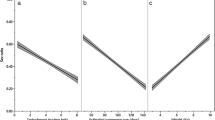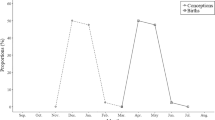Abstract
We report on 14 years of reproductive data for semifree-ranging mandrills (Mandrillus sphinx) in Gabon, and we explore relationships between female rank, age and parity, and reproductive strategies. Most births (61% of 132) occurred during the wet season in Gabon, between January and March. Female rank and parity were unrelated to the timing of parturition. Gestation lengths average 175 days (SE = ±1 day; N = 61) and were similar irrespective of female rank, parity, or sex of offspring. Birth sex ratio did not differ significantly from unity (52% male), and was unrelated to maternal rank or parity. Stillbirths and neonatal mortality tended to be more common among lower-ranking females than among either mid-ranking or dominant females. Median age at first birth is 4.71 years, at a median body mass of 7.6 kg, ca 5 years before females attain their adult body mass (median 12 kg). Age at first reproduction is significantly correlated with dominance rank, with dominant females giving birth on average 1.3 years earlier than lower-ranking females do. Interbirth intervals (IBI) average 405 days (range 184–1159 days, N = 103), and are independent of the sex of the offspring. Infant death within 6 months shortened IBI to 305 days. Increasing age and parity are also associated with short IBI, as is higher rank. Maternal rank and parity appear to influence reproductive success in female mandrills, but there is no apparent differential maternal investment by sex.
Similar content being viewed by others
REFERENCES
Altmann, J. (1980). Baboon Mothers and Infants, Harvard University Press, Harvard.
Altmann, S. A. (1991). Diets of yearling female primates (Papio cynocephalus) predict lifetime fitness. Proc. Natl. Acad. Sci. USA 88: 420–423.
Bercovitch, F.B (1993). Dominance rank and reproductive maturation in male rhesus macaques (Macaca mulatta). J. Reprod. Fert. 99: 113–120.
Bercovitch, F. B., and Berard, J. D. (1993). Life history costs and consequences of rapid reproductive maturation in female rhesus macaques. Behav. Ecol. Sociobiol. 32: 103–109.
Bercovitch, F. B., and Strum, S. C. (1993). Dominance rank, resource availability and reproductive maturation in female savanna baboons. Behav. Ecol. Sociobiol. 33: 313–318.
Berman, C. M. (1988). Maternal condition and offspring sex ratio in a group of free-ranging rhesus monkeys: An 11-year study. Am. Nat. 131: 307–328.
Bettinger, T., Wallis, J., and Morris, A. (1995). Reproductive parameters of mandrills at the Tulsa Zoo. Zoo Biol. 14: 115–121.
Boesch, C. (1997). Evidence for dominant wild chimpanzees investing more in sons. Anim. Behav. 54: 811–815.
Byers, J. A., and Moodie, J. D. (1990). Sex-specific maternal investment in pronghorn, and the question of a limit on differential provisioning in ungulates. Behav. Ecol. Sociobiol. 26: 157–164.
Cheney, D. L., Seyfarth, R. M., Andelman, S. J., and Lee, P. C. (1989). Reproductive success in vervet monkeys. In Clutton-Brock, T. H. (ed.), Reproductive Success, University of Chicago Press, Chicago, pp. 384–402.
Clutton-Brock, T. H. (1991). The Evolution of Parental Care, Princeton University Press, Princeton.
Clutton-Brock, T. H., Albon, S. D., and Guinness, F. E. (1982). Red Deer: The Behaviour and Ecology of Two Sexes, University of Chicago Press, Chicago.
Dixson, A. F., Bossi, T., and Wickings, E. J. (1993). Male dominance and genetically determined reproductive success in the mandrill (Mandrillus sphinx). Primates 34: 525–532.
Feistner, A. T. C. (1990). Reproductive parameters in a semifree-ranging group of mandrills. In De Mello, M. T., Whiten, A., and Byrne, R. (eds.), Baboons: Behaviour and Ecology, Use and Care, University of Brasilia Press, Brasilia, pp. 77–88.
Feistner, A. T. C. (1992). Aspects of reproduction of female mandrills (Mandrillus sphinx). Int. Zoo Yrbk. 31: 170–178.
Gomendio, M. (1990). The influence of maternal rank and infant sex on maternal investment trends in macaques: Birth sex ratios, interbirth intervals and suckling patterns. Behav. Ecol. Sociobiol. 27: 365–375.
Gomendio, M., Clutton-Brock, T. H., Albon, S.D., Guinness, F. E., and Simpson, M. J. A. (1990). Mammalian sex ratios and variation in the costs of rearing sons and daughters. Nature 343: 261–263.
Harcourt, A. H. (1987). Dominance and fertility among female primates. J. Zool. Lond. 213: 471–487.
Hill, W. C. O. (1970). Primates, Comparative Anatomy and Taxonomy, Vol. 8, Cynopithecinae, Papio, Mandrillus, Theropithecus, Edinburgh University Press, Edinburgh.
Hiraiwa-Hasegawa, M.(1993). Skewed birth sex ratios in primates: Should high ranking mothers have daughters? Trends Ecol. Evol. 8: 395–400.
Holekamp, K. E., and Smale, L. (1995). Rapid change in offspring sex ratios after class fission in the spotted hyena. Am. Nat. 145: 261–278.
Itoigawa, N., Tanaka, T., Ukai, N., Fujii, H., Kurokawa, T., Koyama, T., Ando, A., Watanabe, Y., and Imaka, S. (1992). Demography and reproductive parameters of a free-ranging group of Japanese macaques (Macaca fuscata) at Katsuyama. Primates 33: 49–68.
Kojola, I. (1998). Sex ratio and maternal investment in ungulates. Oikos 83: 567–573.
Koyama, N., Takahata, Y., Huffmam, M. A., Norikoshi, K., and Sumb, H. (1992). Reproductive parameters of female Japanese macaques: Thirty years data from the Arashiyama troops, Japan. Primates 33: 33–47.
Kruuk, L. E. B., Clutton-Brock, T. H., Albon, S. D., Pemberton, J. M., and Guinness, F. E. (1999). Population density affects sex ratio variation in red deer. Nature 399: 459–461.
Lee, P. C., and Moss, C. J. (1986). Early maternal investment in male and female African elephants. Behav. Ecol. Sociobiol. 18: 353–361.
Lee, P. C., and Moss, C. J. (1999). The social context for learning and behaviour among wild African elephants. In Box, H. O., and Gibson, K. R. (eds.), Mammalian Social Learning: Comparative and Ecological Perspectives, Cambridge University Press, Cambridge, pp. 102–125.
Leigh, S. R. (1992). Patterns of variation in the ontogeny of primate body size dimorphism. J. Hum. Evol. 23: 27–50.
Lunn, P.G., Austin, S., Prentice, A. M., and Whitehead, R.G. (1984). The effect of improved nutrition on plasma prolactin concentrations and postpartum infertility in lactating Gambian women. Am. J. Clin. Nutrit. 39: 227–235.
McFarland Symington, M. (1987). Sex ratio and maternal rank in wild spider monkeys: When daughters disperse. Behav. Ecol. Sociobiol. 20: 421–425.
Mori, A. (1979). Analysis of population changes by measurement of body weight in theKoshima troop of Japanese monkeys. Primates 20: 371–397.
Muruthi, P., Altmann, J., and Altmann, S. A. (1991). Resource base, parity, and reproductive condition affect female's feeding time and nutrient intake within and between groups of a baboon population. Oecologia 87: 467–472.
Oftedal, O. T. (1984). Milk composition, milk yield and energy output at peak lactation: A comparative review. Symp. Zool. Soc. Lond. 51: 33–85.
Ono, K. A., and Boness, D. J. (1996). Sexual dimorphism in sea lion pups: Differential maternal investment, or sex-specific differences in energy allocation. Behav. Ecol. Sociobiol. 38: 31–41.
Paul, A., and Kuester, J. (1990). Adaptive significance of sex ratio adjustment in semifreeranging Barbary macaques (Macaca sylvanus) at Salem. Behav. Ecol. Sociobiol. 27: 287–293.
Paul, A., and Thommen, D. (1984). Timing of birth, female reproductive success and infant sex ration in semifree-ranging Barbary macaques (Macaca sylvanus) Folia Primatol. 42: 2–16.
Pusey, A., Williams, J., and Goodall, J. (1997). The influence of dominance rank on the reproductive success of female chimpanzees. Science 277: 828–831.
Rosetta, L. (1989). Breast feeding and post-partum amenorrhea in Serere women in Senegal. Ann. Hum. Biol. 16: 311–320.
Setchell, J. M. (1999). Socio-sexual Development in the Male Mandrill (Mandrillus sphinx), PhD Thesis, University of Cambridge.
Simpson, M. J. A., Simpson, A. E., Hooley, J., and Zunz, M. (1981). Infant-related influences on birth intervals in rhesus monkeys. Nature 290: 49–51.
van Schaik, C. P., and Hrdy, S. B. (1991). Intensity of local resource competition shapes the relationship between maternal rank and sex ratios at birth in cercopithecine primates. Am. Nat. 138: 1555–1561.
van Schaik, C. P., van Noordwijk, M. A., and Nunn, C. L. (1999). Sex and social evolution in primates. In Lee, P. C., (ed.), Comparative Primate Socioecology, Cambridge University Press, Cambridge, pp. 204–240.
Whitten, P. L. (1983). Diet and dominance among female vervet monkeys (Cercopithecus aethiops). Am. J. Primatol. 5: 139–159.
Wickings, E. J., and Dixson, A. F. (1992a). Development from birth to sexual maturity in a semifree-ranging colony of mandrills (Mandrillus sphinx) in Gabon. J. Reprod. Fert. 95: 129–138.
Wickings, E. J., and Dixson, A. F. (1992b). Application ofDNAfingerprinting to familial studies of Gabonese primates. In Martin, R. D., Dixson, A. F., and Wickings, E. J. (eds.), Paternity in Primates: Genetic Tests and Theories, Basel, Karger, pp. 113–130.
Wildt, D. E., Doyle, U., Stone, S.C., and Harrison, R. M. (1977). Correlation of perineal swelling with serum ovarian hormone levels, vaginal cytology and ovarian follicular development during the baboon reproductive cycle. Primates 18: 261–270.
Willner, L. A., and Martin, R. D. (1985). Some basic principles of mammalian sexual dimorphism. In Ghesquiere, J., Martin, R. D., and Newcombe, F. (eds.), Human Sexual Dimorphism, Taylor and Francis, London, pp. 1–42.
Wood, J. G. (1994). Dynamics of Human Reproduction, Aldine, New York.
Author information
Authors and Affiliations
Rights and permissions
About this article
Cite this article
Setchell, J.M., Lee, P.C., Wickings, E.J. et al. Reproductive Parameters and Maternal Investment in Mandrills (Mandrillus sphinx). International Journal of Primatology 23, 51–68 (2002). https://doi.org/10.1023/A:1013245707228
Issue Date:
DOI: https://doi.org/10.1023/A:1013245707228




